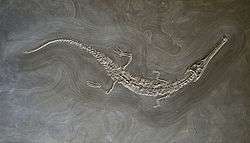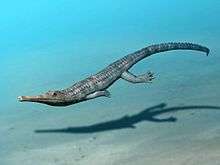Steneosaurus
| Steneosaurus Temporal range: 183–163 Ma | |
|---|---|
 | |
| Steneosaurus bollensis, Holzmaden Germany | |
| Scientific classification | |
| Kingdom: | Animalia |
| Phylum: | Chordata |
| Class: | Sauropsida |
| Infraclass: | Archosauromorpha |
| (unranked): | Mesoeucrocodylia |
| Suborder: | Thalattosuchia |
| Family: | Teleosauridae |
| Genus: | Steneosaurus Geoffroy, 1825 |
| Species | |
| |
| Synonyms | |
| |
Steneosaurus is an extinct genus of teleosaurid crocodyliform from the Early Jurassic to Middle Jurassic (Toarcian to Callovian). Fossil specimens have been found in England, France, Germany, Switzerland and Morocco. The largest species, S. heberti, reached up to 5 m (16.5 ft) long, though 2.5–3.5 m was far more common.[2]

Species
Species in this genus are traditionally classed into two skull groups: longirostrine (long, narrow jaws) and brevirostrine (short, broad jaws).
Longirostrine
- S. baroni: Madagascar from the Bathonian.
- S. bollensis: Western Europe (England, France and Germany) from the Toarcian.
- S. boutilieri: Western Europe (England, France and Switzerland) from the Bathonian.
- S. gracilirostris: Western Europe (England) from the Toarcian.
- S. heberti: Western Europe (France) from the Callovian.
- S. larteti: Western Europe (England and France) from the Bathonian.
- S. leedsi: Western Europe (England and France) from the Callovian.
- S. megistorhynchus: (type) Western Europe (France) from the Bathonian.
- S. pictaviensis: Western Europe (France) from the Callovian.
Brevirostrine
- S. brevior: Western Europe (England) from the Toarcian.
- S. edwardsi: Western Europe (England and France) from the Callovian.
- S. obtusidens: Western Europe (England) from the Callovian.
Evolutionary relationships
A 2005 phylogenetic analysis into the evolutionary relationships of Thalattosuchia did not support the monophyly of Steneosaurus, as the genera Machimosaurus and Teleosaurus both fell within Steneosaurus.[3] Reinforcing the paraphyly of Steneosaurus, the Callovian species Steneosaurus obtusidens has been recovered as the sister species of Machimosaurus in recent cladistic analyses of Thalattosuchia, while Steneosaurus bollensis was recovered in a basal position to other members of Steneosaurus sensu lato.[4][5] Given the paraphyly of Steneosaurus, Macrospondylus von Meyer, 1830 is the earliest available generic name for S. bollensis.
Niche partitioning

Steneosaurus (=Aeolodon) priscus is one of five thalattosuchian species known from the Mörnsheim Formation (Solnhofen limestone, early Tithonian) of Bavaria, Germany. Steneosaurus was the only teleosaurid known from this Formation, co-existing with four metriorhynchid species: Dakosaurus maximus, Geosaurus giganteus, Cricosaurus suevicus and Rhacheosaurus gracilis. It has been hypothesised that niche partitioning enabled several species of crocodyliforms to co-exist. D. maximus and G. giganteus would have been top predators of this Formation, both of which were large, short-snouted species with serrated teeth. The remaining species (S. priscus, C. suevicus and R. gracilis) would have fed mostly on fish.[6]
From the semi-aquatic Oker locality in Lower Saxony, Germany (Kimmeridgian-age) two genera of teleosaurids (Steneosaurus and Machimosaurus) are known, in addition to the neosuchian genera Goniopholis and Theriosuchus.[7] Steneosaurus and Machimosaurus are also found together in the same Tithonian-age deposits of western France.[8]
See also
References
- ↑ Andrews CW. 1913. A descriptive catalogue of the marine reptiles of the Oxford Clay, Part Two. London: British Museum (Natural History), 206 pp.
- ↑ "croco_thalattosuchia". Paleopedia.free.fr. Retrieved 2014-03-02.
- ↑ Mueller-Töwe, I. J. (2005). "Phylogenetic relationships of the Thalattosuchia" (PDF). Zitteliana. A45: 211–213.
- ↑ Young, M. T.; Brusatte, S. L.; De Andrade, M. B.; Desojo, J. B.; Beatty, B. L.; Steel, L.; Fernández, M. S.; Sakamoto, M.; Ruiz-Omeñaca, J. I.; Schoch, R. R. (2012). Butler, Richard J, ed. "The Cranial Osteology and Feeding Ecology of the Metriorhynchid Crocodylomorph Genera Dakosaurus and Plesiosuchus from the Late Jurassic of Europe". PLoS ONE 7 (9): e44985. doi:10.1371/journal.pone.0044985. PMC 3445579. PMID 23028723. edit
- ↑ Martin, J. E. and Vincent, P. (2013), New remains of Machimosaurus hugii von Meyer, 1837 (Crocodilia, Thalattosuchia) from the Kimmeridgian of Germany. Fossil Record, 16: 179–196. doi: 10.1002/mmng.201300009
- ↑ Andrade MB, Young MT. 2008. High diversity of thalattosuchian crocodylians and the niche partition in the Solnhofen Sea. The 56th Symposium of Vertebrate Palaeontology and Comparative Anatomy
- ↑ Karl H-V, Gröning E, Brauckmann C, Schwarz D, Knötschke N.2006. The Late Jurassic crocodiles of the Langenberg near Oker, Lower Saxony (Germany), and description of related materials (with remarks on the history of quarrying the “Langenberg Limestone” and “Obernkirchen Sandstone”). Clausthaler Geowissenschaften 5: 59–77.
- ↑ Billon-Bruyat J-P, Mazin J-M, Buffetaut E, Tong H, Abit D. 2001. New occurrence of vertebrate remains in the latest Jurassic of western France (Oléron island, Charente-Maritime). 6th European Workshop on Vertebrate Palaeontology – Florence and Montevarchi (Italy) – September 19–22, 2001 Abstract Booklet, p. 19